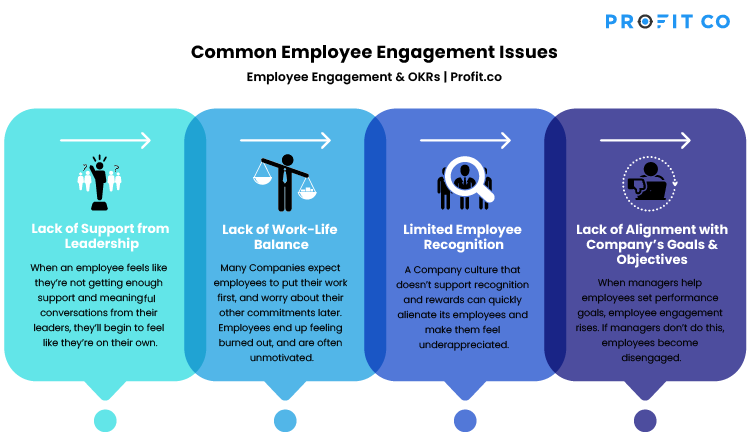While many companies say that employee engagement is an important part of their workplace culture, and experts agree that engagement and productivity are inextricably linked, globally only 20% of employees are engaged at work according to a recent Gallup report. This staggeringly low number shows that many employees aren’t committed to their jobs, and they don’t feel inspired to exceed expectations at work.
Low engagement can lead to a whole host of problems, including employee turnover, which means you’ll end up spending more money on hiring and onboarding.
On the flip side, highly engaged teams show 21% greater profitability, according to Gallup research. The same study also showed that highly-engaged teams experience 59% less turnover.
That’s because engaged employees are more likely to come to work with a sense of urgency, energy, and passion.
Highly engaged employees make the customer experience. Disengaged employees break it.
So, what can you do if you’re dealing with employee engagement issues? Consider using the objectives and key results (OKR) framework.
In this post, we’ll discuss that in more detail. But before we do, let’s talk about why employee engagement is so important in the first place.
Do you want an intuitive and agile software to help manage your OKRs alongside your employee engagement initiatives? Get started on Profit.co for free today!
The Importance of Employee Engagement
If customers are the heart of your organization, then your staff is the backbone. Their work is what holds your company together and keeps it strong.
So, if they’re not engaged in their work, everything can fall apart. For example, a disengaged employee is more likely to leave the company. This means that you have to spend more money recruiting, hiring, and onboarding new people.
And even if a disengaged employee decides to stay, they’re less likely to be productive, which puts your organization in danger of meeting its goals.
Common Employee Engagement Issues

There are various factors that can negatively impact a staff member’s ability to engage at their job. Here are just a few:
- Lack of support from leadership: A manager directly influences 70% of an employee’s motivation. When an employee feels like they’re not getting enough support and meaningful conversations from their leaders, they’ll begin to feel like they’re on their own.
- Lack of work-life balance: Many companies expect employees to put their work first, and worry about their other commitments later. This doesn’t bode well for some employees. They end up feeling burned out, and are often unmotivated. This is a sure way to create disengagement.
- Limited employee recognition: Lack of appreciation is one of the many reasons why employees quit their jobs. A company culture that doesn’t support recognition and rewards can quickly alienate its employees and make them feel underappreciated.
- No alignment with company’s goals and objectives: When managers help employees set performance goals, employee engagement rises to 69%. On the other hand, when managers don’t help employees set these goals, 53% of employees can become disengaged at work.
How OKRs Can Address Employee Engagement Issues
If your employees have problems with lack of engagement, you might consider OKR to boost performance, morale, and motivation.
OKR and employee engagement methodology will allow you to set goals on company, team, and personal levels. In addition, OKRs allow you to track progress with these goals
Here’s a general overview of OKR and employee engagement:
- Objectives: Ambitious goals that are in line with company values and strategy.
- Key Results: Measurable, achievable benchmarks or targets that measure the success of your objective.
So what’s the relationship between OKR and employee engagement? OKR creates a framework for alignment and transparency to an organization’s vision.
This can inspire teams to give more, try harder, be more creative, and engage.
That’s because OKR holds employees accountable for their performance, which motivates them to perform better and work toward achieving the goals.
Examples of HR OKRs
There are several HR OKR examples you can use to implement into your employee engagement strategy.
- Compensation: Your objective might be to increase your benefit program but stay within your budget. A key result could be to get 85% of your employees to participate in the program.
- Performance: Imagine that your objective is to increase performance across your sales team. One KR could be increasing the close rate from 22% to 27% or growing average deal size from $10k to $12k.
- Education and training: An objective could be to implement a personal development program for all team members. A key result might be to achieve at least an 80% completion rate for the personal development program.
- Culture and retention: Imagine that your objective is to create a more goal-oriented company culture. A key result may be to achieve 80% of objectives.
- Hiring and recruiting: For this OKR, one objective could be to reduce failed hire rates. The KR could create a detailed recruitment plan and reduce the average hiring time by 15%.
As you’ve likely noticed in these examples, the objectives you set should be specific and actionable, making them easy to plan for and measure. This is what makes engagement OKRs so effective.
Giving employees a goal to work towards is one of the best ways to boost employee engagement. It makes them feel like they have a more defined purpose at work, which can improve motivation and morale.
To learn more about how you can track OKRs to transform your employee engagement and achievement, book a free demo with our OKR experts.

